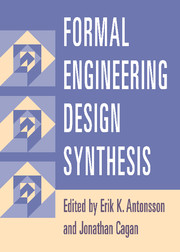Book contents
- Frontmatter
- Contents
- Contributing Authors
- Foreword
- Preface
- Introduction
- 1 Vitruvius Redux
- 2 How to Calculate with Shapes
- 3 Engineering Shape Grammars
- 4 Creating Structural Configurations
- 5 Microsystem Design Synthesis
- 6 Function-Based Synthesis Methods in Engineering Design
- 7 Artificial Intelligence for Design
- 8 Evolutionary and Adaptive Synthesis Methods
- 9 Kinematic Synthesis
- 10 Systematic Chemical Process Synthesis
- 11 Synthesis of Analog and Mixed-Signal Integrated Electronic Circuits
- 12 Mechanical Design Compilers
- 13 Scientific Discovery and Inventive Engineering Design
- Index
10 - Systematic Chemical Process Synthesis
Published online by Cambridge University Press: 10 October 2009
- Frontmatter
- Contents
- Contributing Authors
- Foreword
- Preface
- Introduction
- 1 Vitruvius Redux
- 2 How to Calculate with Shapes
- 3 Engineering Shape Grammars
- 4 Creating Structural Configurations
- 5 Microsystem Design Synthesis
- 6 Function-Based Synthesis Methods in Engineering Design
- 7 Artificial Intelligence for Design
- 8 Evolutionary and Adaptive Synthesis Methods
- 9 Kinematic Synthesis
- 10 Systematic Chemical Process Synthesis
- 11 Synthesis of Analog and Mixed-Signal Integrated Electronic Circuits
- 12 Mechanical Design Compilers
- 13 Scientific Discovery and Inventive Engineering Design
- Index
Summary
INTRODUCTION
Chemical processing involves the transformation of one composition or form of matter into another, most often via chemical reactions and purifications, but also through other transforming operations as well. Although criticized by the public and government alike, chemical processing plays a central role in the manufacture of a myriad of everyday materials, such as brick, mortar, steel, aluminum, glass, paper, plastics, rubber, concrete, asphalt, gasoline, plaster, fibers, dyes, paint, adhesives, soap, photographic film, computer chips, pharmaceuticals, vitamins, fertilizers, pesticides, foods, wine, and drinking water, as well as in such activities as food preservation, sewage treatment, power generation, smog prevention, and clothes cleaning. These activities are conducted naturally by biological organisms and intentionally by mankind in both batchwise and continuous modes. Production scales range from micrograms to gigatons, at locations as varied as the backyard pond, the kitchen, an oil refinery, a pharmaceutical plant, or a steel mill. Chemical processing primarily involves the interconversion of one material into another rather than the formation of materials into an artifact or the design of functionality into an artifact.
Process systems engineering is that branch of chemical engineering concerned with the design, operation, and control of chemical processes. Process systems engineers make much use of computer simulation and mathematical techniques to optimize potential chemical plant designs before such plants are actually constructed and operated. However, before any process design alternative may be modeled, simulated, analyzed, or optimized, it must first be invented or synthesized.
- Type
- Chapter
- Information
- Formal Engineering Design Synthesis , pp. 362 - 390Publisher: Cambridge University PressPrint publication year: 2001
- 3
- Cited by



